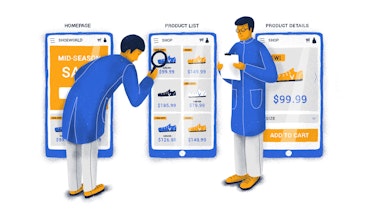Monetizing an app is not an easy process. There is a wide variety of options when it comes to generating income with your app. The critical question, however, is this: “What’s the best approach for your product?”
Some choose in-app purchases over a mandatory annual membership fee. Others rely on a freemium model over a paid-only approach. Introducing a fee is a risky process that demands meticulous consideration.
In this article, we’ll look into essential app monetization challenges and how focusing on user experience can help you overcome them. Let’s dive right in!
App Monetization Strategies
Here are the three strategies we think are effective in mobile app monetization.
1. The problem with monetizing through ads
Advertisement is a prevalent solution among app publishers. It was especially popular 10 years ago, when user experience wasn’t as big as it is today. How are ads and UX connected? The former is often a disruptive factor for the latter. Simply put, poorly integrated apps annoy people.
More importantly, the concept of banner blindness is still relevant today. We, as frequent users of various types of interfaces, are disincentivized to click on or look at ads. We don’t just do this consciously, but unconsciously as well. It’s almost a sort of adaptation to the digital environment we live in.
When positioned awkwardly, ads can harm your CTR. This, as a result, will lead to low payouts and low customer retention. A study published by the Reuters Institute showed that a third of the respondents actively avoided ads. More importantly, they also avoided sites and platforms where ads interfered with the content too much.
How can I address this?
When planning your ad monetization strategy, you always need to have users in mind. There are a few steps we can take to ensure a positive ad experience:
Know what you advertise. Make sure that the products you promote are ethically aligned with your brand.
Find the best way to integrate your ads. Banners that diminish your customers’ experience will do more harm than good.
Consider going the more creative route and opt for native ads and targeted ads. It’s proven that this type of advertisement has much higher engagement rates compared to banners.
2. Be mindful of retention rate
Acquiring users is expensive. There is a massive difference between how much we pay for a user who downloaded the app and one who became a paying user.
After analyzing a year’s worth of data, Liftoff, a mobile app marketing agency, calculated the average cost to acquire a user.
Their findings are intriguing and worrying at the same time. The cost of acquiring a user who will end up making an in-app purchase is a few cents shy of $65. But acquiring a user who will subscribe to a paid service is around $162.
What does this data tell us? For one thing, app publishers should invest a great deal of time in the usability of their products. Otherwise, the costs of customer acquisition may leave an irreparable dent in your budget. This, as a result, could endanger your app’s profitability.
How can I address this?
It is possible to increase an app’s retention rate and decrease acquisition costs by investing in UX research. This will ensure that your users don’t experience unnecessary friction while using your app.
Furthermore, UX research is proven to increase revenue. There is a large body of research showing that well-designed sites and apps end up securing more sales.
3. Providing real value with premium
Today, allowing users to download the app for free is typical. Once the free app is downloaded, there are a few ways that a publisher can choose to monetize:
Freemium. This implies that the user can enjoy the full functionality of the app for a limited amount of time. Once the trial is over, they are expected to pay a one-time fee to continue using the app. Some sources suggest that purchase rates range between 0.5% and 2% with freemium monetization.
Subscription. This model partly overlaps with freemium. For example, services like Medium or HBR allow a limited number of premium articles per month. However, users often have to pay first to even use the app or service, e.g., Netflix.
Premium. This is a model that’s much more popular with established brands. You have profiles that are free forever yet have limited functionality. Then, there are others that provide a little extra, but for an extra fee.
The first two models are similar by providing evident value for the user once they switch to a paid account. Publishers, however, often make serious mistakes when formulating their premium memberships, ones that can seriously endanger the success of their apps or services.
Many choose to simply remove ads as their main premium benefit. Ads aren’t unethical as such, but the idea is that they leverage the users’ discomfort. Is this real value that users are getting? Definitely not.
On a similar note, it is also essential to properly formulate the benefits of a premium account. Back in 2014, HBR published an article discussing freemium models and exploring the idea that services often fail to provide value with their premium propositions.
Dropbox and LinkedIn are a study in contrasts. The former has attracted 200 million users with a simple proposition: Everyone who enters a username and a password gets two gigabytes of cloud-based storage free. If people run out of space, they can pay $9.99 a month (or, alternatively, $99 a year) for 100 GB of storage.
For many LinkedIn users, the advantages of upgrading are murkier. [...] I routinely receive e-mails urging me to upgrade—but the ongoing value of doing so is not apparent.
Source: HBR.org
How can I address this?
Make sure your premiums provide more than just an ad-free experience.
Your premium proposition has to be clear and simple.
Conclusion
Mobile app monetization comes with a broad spectrum of challenges. Aside from finding the best way to extract revenue from it, we need to also ensure that our users receive maximum value. This is more than a nice-to-have. It’s gradually becoming an imperative across industries.




